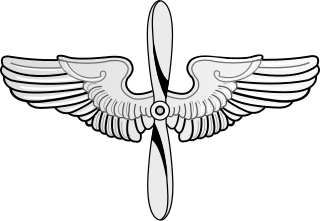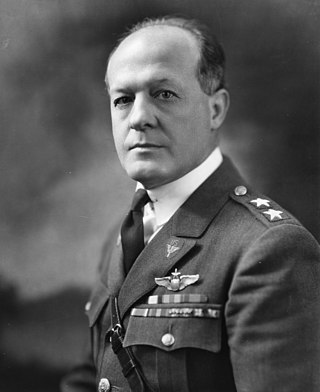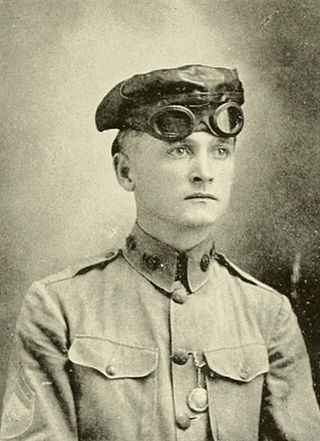
An airship or dirigible balloon is a type of aerostat or lighter-than-air aircraft that can navigate through the air under its own power. Aerostats gain their lift from a lifting gas that is less dense than the surrounding air.
This is a list of aviation-related events from 1910:

This is a list of aviation-related events from 1912:
This is a list of aviation-related events from 1914.
This is a list of aviation-related events from 1916:

The United States Army Air Service (USAAS) was the aerial warfare service component of the United States Army between 1918 and 1926 and a forerunner of the United States Air Force. It was established as an independent but temporary branch of the U.S. War Department during World War I by two executive orders of President Woodrow Wilson: on May 24, 1918, replacing the Aviation Section, Signal Corps as the nation's air force; and March 19, 1919, establishing a military Director of Air Service to control all aviation activities. Its life was extended for another year in July 1919, during which time Congress passed the legislation necessary to make it a permanent establishment. The National Defense Act of 1920 assigned the Air Service the status of "combatant arm of the line" of the United States Army with a major general in command.

A United States Aviator Badge refers to three types of aviation badges issued by the United States Armed Forces, those being for Air Force, Army, and Naval aviation.

A hangar is a building or structure designed to hold aircraft or spacecraft. Hangars are built of metal, wood, or concrete. The word hangar comes from Middle French hanghart, of Germanic origin, from Frankish *haimgard, from *haim and gard ("yard"). The term, gard, comes from the Old Norse garðr.
This is a list of aviation-related events during the 19th century :
Ashley Chadbourne McKinley was an accomplished American aerial photographer and colonel in the U.S. Army Air Corps who helped pioneer aviation at subzero temperatures. He accompanied Richard E. Byrd as an aerial photographer on his expedition to the South Pole.

The Balloon Pilot Badge is a military badge of the United States Armed Forces which was issued during the First and Second World Wars. The badge was issued by both the United States Army and the U.S. Air Force, with the Navy equivalent known as the Dirigible Pilot Badge.

Benjamin Delahauf Foulois was a United States Army general who learned to fly the first military planes purchased from the Wright brothers. He became the first military aviator as an airship pilot, and achieved numerous other military aviation "firsts". He led strategic development of the Air Force in the United States.
The Aircrew Badge, commonly known as Wings, is a qualification badge of the United States military that is awarded by all five branches of armed services to personnel who serve as aircrew members on board military aircraft. The badge is intended to recognize the training and qualifications required by aircrew of military aircraft. In order to qualify as an aircrew member and receive the Aircrew Badge, such personnel typically undergo advanced training in aircraft in-flight support roles.

Thomas Scott Baldwin was a pioneer balloonist and U.S. Army major during World War I. He was the first American to descend from a balloon by parachute.

The Aeronautical Division, Signal Corps (1907–1914) was the first heavier-than-air military aviation organization in history and the progenitor of the United States Air Force. A component of the U.S. Army Signal Corps, the Aeronautical Division procured the first powered military aircraft in 1909, created schools to train its aviators, and initiated a rating system for pilot qualifications. It organized and deployed the first permanent American aviation unit, the 1st Aero Squadron, in 1913. The Aeronautical Division trained 51 officers and 2 enlisted men as pilots, and incurred 13 fatalities in air crashes. During this period, the Aeronautical Division had 29 factory-built aircraft in its inventory, built a 30th from spare parts, and leased a civilian airplane for a short period in 1911.

The Aviation Section, Signal Corps, was the aerial warfare service of the United States from 1914 to 1918, and a direct statutory ancestor of the United States Air Force. It absorbed and replaced the Aeronautical Division, Signal Corps, and conducted the activities of Army aviation until its statutory responsibilities were suspended by President Woodrow Wilson in 1918. The Aviation Section organized the first squadrons of the aviation arm and conducted the first military operations by United States aviation on foreign soil.

U.S. Air Force aeronautical ratings are military aviation skill standards established and awarded by the United States Air Force for commissioned officers participating in "regular and frequent flight", either aerially or in space, in performance of their duties. USAF aeronautical badges, commonly referred to as "wings" from their shape and their historical legacy, are awarded by the Air Force in recognition of degrees of achievement and experience. Officers earning these badges and maintaining their requirements are classified as rated officers and receive additional pay and allowances.

The Second Bombardment Wing, abbreviated as 2nd Bombardment Wing of the United States Army Air Forces is a disbanded unit whose last assignment was with the Continental Air Forces, based at McChord Field, Washington. It was last active in November 1945.

Vernon Lee Burge was an aviation pioneer. He was the first American enlisted man to be certified as a military pilot. After ten years as an enlisted man, Burge was commissioned during World War I and served the next 25 years as an officer.

Henry Post Army Airfield is a military use airport located at Fort Sill in Comanche County, Oklahoma, United States. This military airport is owned by United States Army. Established as Post Field in 1917, it was one of thirty-two Air Service training camps established after the United States entry into World War I in April 1917.














